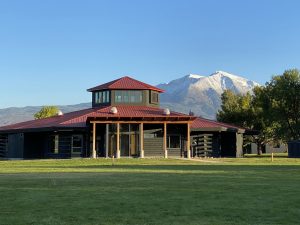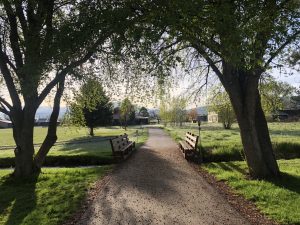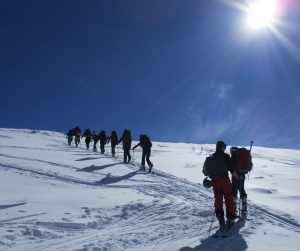Wilderness Orientation Q&A
Here at Colorado Rocky Mountain School, we have been venturing into the outdoors since our founding in 1953. In the early days, the school piled everyone into the back of canvas-covered International Harvester trucks and drove to the red rock deserts of southeastern Utah to explore, camp, and seek both adventure and reflection.
Today several times a year we run self-contained climbing, kayaking, canoeing, backpacking, and mountain biking expeditions across western Colorado and to some of those very same southeastern Utah deserts visited in our early days. Since the school’s founding, CRMS students have been backpacking and climbing mountains, exploring canyons, and running rivers across the west. We feel confident that you too will come to value and appreciate your experiences on these invaluable public lands.
The first trip that all students go on when they arrive at CRMS is Wilderness Orientation. It is a 10-day service and backpacking trip in the Colorado Rocky Mountains. Since we know that students and families are curious about this trip, we offer the following answers to some of the more frequently asked questions.
What if I’ve never backpacked or done anything like this before?
No problem! We take strides to design our Wilderness Orientation to accommodate students with little to no outdoor experience up to students who have grown up adventuring in the outdoors. Your experienced leaders will be there to teach you the skills and to help you become proficient in outdoor living. For sure backpacking involves carrying a heavy pack and hiking on and off-trail over rugged terrain, but you will have time to acclimatize and practice the skills needed to travel and live in the outdoors.
If you haven’t yet had the opportunity to experience a sunset over an alpine lake, or the feeling of making it to the top of a high mountain pass or peak, or the satisfaction of preparing a yummy meal with new friends over a camp stove you are in for a potent and powerful experience. It is one that upon reflection, our students (including those that were total novices when they arrived at CRMS) later share as having been some of the most powerful of their time at CRMS.
What about all the gear I need?
Each year we receive numerous questions about gear and equipment. As such we have provided both the detailed Wilderness Orientation Equipment List and described many details about this gear in our Wilderness Orientation Primer.
Outdoor gear can be quite expensive, but affordable gear options can be found. Borrowing gear, buying lightly used equipment, and shopping for clearance gear are all possible strategies to save money while getting equipped for Wilderness.
This blog talks about used online gear shops and gives some ideas that might be worth exploring.
Here’s another blog that suggests the cheapest gear they recommend. While this post is from 2015, and although some items it highlights are dated, the rationale and balance of information helps describes what you get if you choose to spend more.
Finally, CRMS has a limited supply of backpacks to loan. If you’re interested, please call the bookstore (970-963-2562) and reserve these items in advance. It’s also worth noting that CRMS students will participate in many outdoor adventures each year, ensuring your investment in outdoor gear will be used regularly during their time at CRMS, and we hope for many years to come after.
What if I’m not outdoorsy or in good shape?
We expect that many of our new students will be novices and perhaps even skeptical about outdoor adventures and living. Whether you identify as an outdoorsy person or an athlete is not important. What is essential is approaching Wilderness Orientation and new experiences with openness and a willingness to engage and participate. Since we have been beginning every school year since the early 1970s with Wilderness, we know how students respond to the demands of the program. Our experience tells us that even students who arrive at CRMS in poor physical shape are capable of finding success and completing Outdoor Orientation. We also know that students who make an effort to improve their fitness and spend time preparing for the adventure minimize some of the physical challenges and discomfort.
Simply getting out and hiking, jogging, playing sports, or any other activity that gets your heart rate up and keeps it up for some time will help improve your cardiovascular fitness and make your transition onto your Wilderness Orientation Trip that much easier. Beginning at least 3-4 weeks before your trip and spending 1-2 hours a week initially, and then building up to 3-4+ hours a week of cardiovascular activity will make a big difference in your body’s ability to meet the demands of the program. See Wilderness Fitness Expectations to learn more about how you can best prepare. If despite your best intentions, you are unable to get out and be active and train, don’t despair. Focus on arriving rested, well-fed and hydrated with an openness to new experiences and challenges, and you will do fine. If you live at sea level, you might consider arriving early at elevation (Carbondale is at 6181’, and Denver is at 5380’ above sea level) to allow your body to begin the acclimatization process.
What about Lions, Tigers, and Bears? Is there scary wildlife or other critters I need to be aware of?
Wilderness Orientation visits our “backyard” wilderness areas made up of sub-alpine and alpine tundra ecosystems. Ranging in elevation from 9000 -13,000+ feet above sea level these ecosystems offer unique opportunities to explore public lands that were set aside due to their unique and “untrammeled” natural qualities and grandeur.
Commonly seen wildlife in these ecosystems include squirrels, chipmunks, porcupines, marmots, pika, mule deer, elk, coyotes, and a myriad of birds (including hawks, eagles, woodpeckers, and songbirds). If you’re lucky you might spot a bighorn sheep, a mountain goat, porcupine, pine marten (a relative of the weasel family), beaver, or yes, maybe even a black bear.
Wildlife is tentative around humans and goes to lengths to avoid us. Since some wildlife can be attracted to human food, we take care to isolate, and properly store our food and any items that might attract animals away from our groups when we are sleeping at night. Oh yeah, in case you weren’t aware there are no Lions or Tigers in Colorado or the United States for that matter except in zoos and sanctuaries.
We do occasionally encounter mosquitos and other biting and stinging insects, but these are of minimal concern in the late summer when Wilderness happens and can be dealt with by a combination of wearing loose-fitting long layers, and using insect repellant.
How do you go to the bathroom in the outdoors?
Whether voiced or not, this is probably one of the most commonly pondered questions about backpacking and adventuring when modern facilities are unavailable. It’s not difficult. It may help to think about some of the less desirable and smelly bathrooms you have experienced in your life as this may help you begin to appreciate that going to the bathroom in the great outdoors can be quite pleasant. Urinating is a simple matter of finding a private place and taking a pee. Girls will be taught about the use of a pee rag (typically a bandana used to dry themselves after urinating). Did you know urine is sterile?
Pooping in the wilderness is also pretty straightforward. Generally speaking, you dig a ‘cathole’ with a small trowel, take care of business, and pack out any TP you use. If you’re in an area that sees a high number of visitors or has other special rules, you might use a product called a wag bag, which allows you to pack everything out. If you’d like to learn more about taking care of these daily necessities, I’d direct you to a great blog post from Outward Bound that you can access here.
What if I get my period?
Because intense physical activity, that your body is not accustomed to, can cause a bit of irregularity with your cycle, we encourage ladies to pack extra feminine hygiene supplies in case their menstrual cycle happens during Outdoor Orientation. Proper backcountry etiquette is to pack out all used supplies, just like with TP, and we will provide bags to do so and ensure all students have support and instruction to understand and feel confident addressing normal physiological functions.
We can’t wait to see you in August for New Family Orientation and the start of your CRMS adventure. If you have any additional questions about Wilderness Orientation, please feel free to reach out to Diane Hackl, Director of Active Programs.
 MYCRMS
MYCRMS





 Virtual Tour
Virtual Tour

